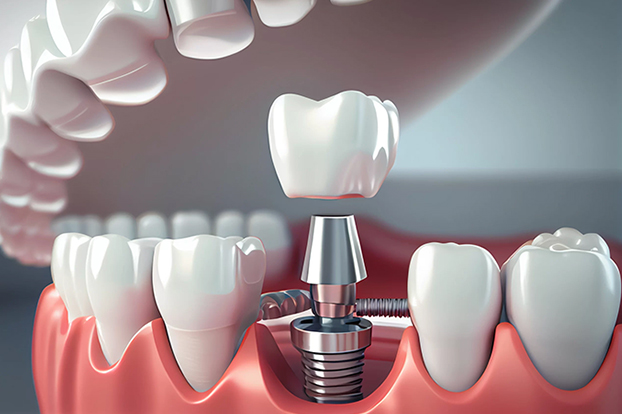Dental Implant Restoration

Restoration of Dental Implants
A summary of dental implant restoration
Recent data from the National Health and Nutrition Examination Survey, as reported by the Center for Disease Control and Prevention, shows that 91% of adults aged 20–64 have dental caries, with 27% having untreated tooth decay that can lead to tooth loss. However, tooth decay is not the only cause of tooth loss; gum disease and accidents are also common factors. By age 44, an estimated 69% of Americans have lost at least one tooth, highlighting the growing issue of tooth loss.
One popular solution for tooth loss is dental implants, which provide a more permanent and natural-looking alternative to dentures. While dental implants are designed to last for many years, they still require maintenance. This is where implant restoration comes in, which aims to restore the strength, appearance, and function of a dental implant that has become damaged or loose.
“Dentists can work with their dental lab and the patient to create custom-fitting dental crowns that may restore a tooth’s shape and size to near perfect.”
Dental implant restoration is required when needed.
- Poor Oral Hygiene: Maintaining a consistent oral hygiene routine is essential, including brushing several times a day, flossing, using mouthwash, and monitoring any issues in the mouth.
- Fractured Dental Implant: If a dental implant fractures, a dentist will need to remove the broken pieces and replace the implant.
- Loose Dental Implant: Conditions such as gum recession, gum disease, and failure of the implant to stabilize the jaw can cause a loose implant. Prompt assistance is crucial if an implant becomes loose.
- Worn-Down Implant: While dental implants can last for decades, they may still suffer damage from aging or issues like teeth grinding.
- Cosmetic Concerns: Cosmetic issues, such as discoloration, can also be improved through implant restoration.
“When a patient has an issue with a dental implant, it is best to seek assistance from a professional.”
The procedure for implant restoration is outlined below:
Every restoration procedure is unique. If complications arise with the dental implant and restoration is needed, the dentist will perform an oral examination to assess the severity of the issues and the root cause. Our team is available to address any questions you may have. The dentist may suggest additional dental treatments, such as gum disease treatment, bone grafting, and gum grafting.
When it comes to replacing a dental implant, the current implant is usually removed and replaced with either a screw-retained or cement-retained restoration. These are the two main types of dental implant restorations. According to FOR.org, both types have complication rates of approximately 3%. A screw-retained restoration offers secure retention and is easy to tighten if it becomes loose, but it may not be as aesthetically pleasing. On the other hand, many find cement-retained restorations to be more visually appealing, but they can be more challenging to adjust if issues arise with the implant. Our team can assist you in determining which type is most suitable for you.
“If complications develop with the dental implant and restoration is necessary, the dentist will conduct an oral examination to determine the severity of the issues and the underlying cause.”
The procedure has been completed
Following an implant restoration, it is common to experience some discomfort and receive aftercare instructions. To help speed up recovery and prevent irritation, it is recommended to stick to a soft diet of nutritious foods and avoid sugary beverages. Patients should also attend routine follow-up visits.
To prolong the lifespan of dental implants and reduce the need for restoration, it is advised to avoid certain foods, tobacco products, and smoking. When caring for dental implants, using a low-abrasion toothpaste and a soft-bristled toothbrush is recommended. Additionally, special flosses and interdental brushes can help maintain the cleanliness and health of the area surrounding the dental implants.
“You can take steps to make your dental implants last and reduce the need for implant restoration.”
Implants that are lost or fractured
If the crown is loose or broken, or if the abutment connecting it to the implant is loose, it can usually be easily fixed. However, if the actual implant post is loose or fractured, the situation becomes more complicated. A broken implant post will need to be removed and replaced with a new one. The same applies to a loose implant post, although in some cases, the crown may be able to be reused on the new implant. If there has been bone loss, bone grafting and healing time may be necessary before a new implant can be placed.
Regardless of the cause, a loose implant should be treated as a dental emergency. Ignoring a loose implant can lead to bone loss, infection, and worsening damage. If you experience a loose or damaged implant, contact our team immediately for assistance.




